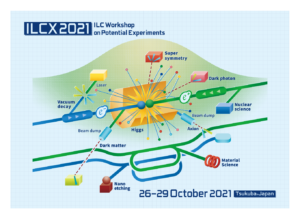Lots of new ideas for physics at the ILC discussed during ILCX
If you think that the International Linear Collider (ILC) is going to be a one-trick pony for studying the Higgs boson, think again. In fact, think research for self-driving cars, think dark matter with axions or dark photons, customs X-rays in a tunnel, photon beams to create tetraquarks and pentaquarks, energy recovery… all these ideas and more were presented and discussed at the recent ILCX 2021 meeting, called into being by ILC International Development Team (IDT) physics and detectors chair Hitoshi Murayama.

“The ILC hasn’t been built yet and it would be a waste of time and creative energy not to think of all the things we could do with it,” Murayama says. “We better have new ideas for the near-term and the long-term future of this project.” Some 600 people registered to the virtual meeting that was advertised as being “about all possible experimental opportunities at the ILC laboratory“ and brought together experimental, theoretical, and accelerator physicists from inside and outside the ILC community.
One of these newcomers to the community is Susanne Westhoff, a junior professor for theoretical physics at Heidelberg University in Germany. She presented an idea for an experiment that would look for particles that live for a relatively long time, interact very little and could tell us more about mysterious phenomena like dark matter. “New long-lived particles might very well exist,” she says. “They are hard to catch in the lab with conventional tools, but they can tell us so much about our Universe, especially when we combine data from colliders with ideas from cosmology.” One such particle candidate could be the dark photon, a potential messenger particle for dark matter.
Originally proposed as a “tag-along” experiment for Belle II at KEK in Japan, she says her experiment might also work, possibly with bigger potential, at other colliders like the ILC or FCC-ee. She and her students are currently studying the best possible place and technology for such a detector. There are several scenarios – a detector placed underground in a new cavern, or a detector above ground. At best they should be the size of a swimming pool and use relatively cheap and almost off-the-shelf silicon detector technology. She is also studying how likely it is that the ILC’s proposed detectors themselves could discover new long-lived particles.
The beam dump played a big role in many experiment ideas presented at ILCX. Normally it is just what it says: the place where the beams get dumped and forgotten after they’ve been brought to collision. Why not let it hit a target and see if that produces light particles like axions, which are also candidates for dark matter? Or put a self-driving car (or at least its control unit) in the way of the dumped beam to study and eventually solve the problem of possible malfunctions due to ionising radiation that the self-driving cars could be affected by while on the road? Or turn the beam dump into a muon tomograph to X-ray lories for customs purposes? Or how about not dumping the beam at all but decelerating it after collision to extract the massive amount of power still stored inside in order to use it for powering the research campus or neighbouring towns?
We can also extract the beam to simulate Hawking radiation from the black hole in a controlled laboratory experiment. Instead of strong gravitational field near the black hole horizon, we can create a strong electric field using a collision of high-energy electrons and powerful laser. Once the field exceeds the “Schwinger field”, we expect to see an avalanche of electron position pairs akin to Hawking radiation. Or use photons from the undulator build for the positron source and look for axions “shining through the wall.” Or another extracted beam to create “tetra quark” and “penta quark” states.
“I am very happy that so many creative ideas came out of the meeting, which shows the potential the ILC has in many directions,” concludes Murayama. “But for me, the best thing that came out was that we have expanded our community and met new people and their ideas.”

Recent Comments